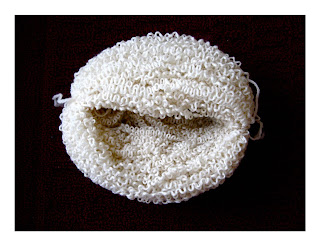What a great question!
Yarn, of course, is twisted in its very nature--that's how it's made. Specifically, yarn involves imparting twist to overlapping lengths of raw fiber--the twist holds the fibers in place. In other words, yarn is twisted out of raw fiber--no twist, no yarn. The problem is therefore not twist itself, but too MUCH twist--overtwist as it is sometimes called.
Yarn, of course, is twisted in its very nature--that's how it's made. Specifically, yarn involves imparting twist to overlapping lengths of raw fiber--the twist holds the fibers in place. In other words, yarn is twisted out of raw fiber--no twist, no yarn. The problem is therefore not twist itself, but too MUCH twist--overtwist as it is sometimes called.
Spinners, both hand- and commercial- have come up with clever, clever ways of restraining the power of the twist to the yarn itself, so that the twist does not cause problems in the finished fabric. Yarn made of several plies (i.e., twisted, then countertwisted) is one familiar example. However, sometimes these spinning strategies do not succeed, or sometimes we knitters inadvertently add excess twist to yarn by winding and re-winding yarn, center-pulling each time.
The most obvious announcement of overtwisted yarn is when the yarn itself humps up, twisting and writhing in the stretch between the skein of yarn and the knitting.
 |
| overspun yarn twisting and writhing |
This sort of overtwisted yarn is usually dealt with by stopping every so often and letting the project dangle, slowly turning and turning, to rid the excess twist.
Although this sort of overtwisted yarn is annoying, at least you know what you have and can take steps. More often, overtwist is sneakier than this. The yarn is overtwisted, yes, but not enough to announce itself in the yarn. Instead, this sneaky kind of overtwist announces itself first when the finished fabric biases (slants).
 |
| biased knitted fabric |
Biased fabric is actually all-too-common. Commercially knit garments often suffer this problem, and it is most obvious when you see sweater seams not hanging straight, but instead, spiraling around the torso of the wearer. Sometimes, not only do the seams spiral, but the entire garment is biased ("racked") also. Hand knit garments, sadly, can also suffer this problem.
 |
| biased ("racked") garment with spiraling seams |
It may happen that the yarn itself is overtwisted when bought, a sad state of affairs. However, we can at least avoid ADDING to the problem, and that is why it pays to take whatever steps possible to avoid creating additional, excess yarn twist. The previous post indicates how to do this: smoothly unspooling yarn from the outside of the skein or cake into which it is wound.
(PS: Since the last post, I found a demo of a neat-o gadget which helps with smooth unspooling: a "yarn susan." The demo at the link does not mention the twist issue, but does clearly show what unspooling smoothly from the outside of a skein ought to look like.)
--TK
You have been reading TECHknitting blog on "avoiding twisted yarn--why does it matter?"













